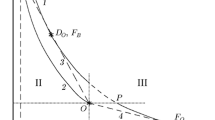Abstract
The transition of slow combustion of a hydrocarbon—air mixture to self-sustaining detonation is investigated experimentally in a model tube with the mixture ignited at the closed end. Various mechanisms of the onset of detonation are discussed, along with the transition of the resulting strong detonation to self-sustainment. The influence of a mechanical obstacle placed at the end of the transition zone on the stabilization of the detonation starting point and the shortening of the transition length is investigated.
Similar content being viewed by others
Literature Cited
K. I. Shchelkin and Ya. K. Troshin, Gas Dynamics of Combustion [in Russian], Izd. AN SSSR, Moscow (1963).
Ya. B. Zel'dovich and A. S. Kompaneets, Theory of Detonation [in Russian], Gostekhizdat, Moscow (1955).
L. N. Khitrin, Physics of Combustion and Explosion [in Russian], Izd. Mosk. Univ., Moscow (1957).
B. Lewis and G. von Elbe, Combustion, Flames, and Explosions of Gases, Academic Press, New York (1961).
G. D. Salamandra, T. V. Bazhenova, S. G. Zaitsev, et al., Methods of Investigation of Short-Time Processes and Their Application to the Study of the Evolution of a Detonation Wave [in Russian], Izd. AN SSSR, Moscow (1960).
P. A. Urtiew and A. K. Oppenheim, “Experimental observation of the transition to detonation in an explosive gas,” Proc. R. Soc. London Ser. A,295, 13 (1966).
A. K. Oppenheim, A. J. Laderman, and P. A. Urtiew, “On the onset of retonation,” Combust. Flame.6, 193 (1962).
R. I. Soloukhin, “Transition from combustion to detonation in gases”, Prikl. Mekh. Tekh. Fiz., No. 4, 128–132 (1961).
A. N. Voinov, “Experimental study of detonation in engines,” in: Combustion in Vehicular Piston Engines [in Russian], E. A. Chudakov (ed.), Izd. AN SSSR, Moscow (1951), p. 112.
A. S. Sokolik, “Fundamentals of the theory of detonation in engines,” in: Combustion in Vehicular Piston Engines [in Russian], E. A. Chudakov (ed.), Izd. AN SSSR, Moscow (1951), p. 185.
S. M. Frolov, B. E. Gel'fand, and S. A. Tsyganov, “Spontaneous combustion regimes,” Fiz. Goreniya Vzryva,28, No. 5, 13–27 (1992).
M. A. Nettleton, Gaseous Detonations: Their Nature, Causes, and Control, Chapman and Hall, New York (1987).
V. V. Mitrofanov (ed.), Problems in the Utilization of Detonation in Technological Processes [in Russian], (collected scientific papers), IGiL SO AN SSSR, Novosibirsk (1986).
K. N. Shavshev, V. N. Tovchigrechko, L. Yu. Sobolev, et al., “Experimental and theoretical studies of strong acoustic pulses in the atmosphere,” Akust. Zh.,34, No. 2, 232–236 (1988).
A. P. Boichenko and N. N. Smirnov, “Dynamics of the interaction of a hot-gas detonation drilling tool with soils,” in: Problems in the Interaction Dynamics of Deformable Media [in Russian], Izd. An Arm. SSR, Erevan (1984), pp. 75–79.
A. A. Borisov and S. A. Loban', “Detonation limits of hydrocarbon—air mixtures in tubes,” Fiz. Gorenlya Vzryva,13, No. 5, 729–733 (1977).
R. P. Lindstedt and H. J. Michels, “Deflagration to detonation transition in mixtures of alkane LNG/LPG constitutents with O2/N2,” Combust. Flame,72, No. 1, 63–72 (1988).
R. P. Lindstedt and H. J. Michels, “Deflagration to detonation transitions and strong deflagrations in alkane and alkene air mixtures,” Combust. Flame,76, No. 2, 169–181 (1989).
A. A. Vasil'ev, “Optimization of the conditions of combustion-to-detonation transition for gas mixtures,” in: Proceedings of an All-Union Symposium (Alma-Ata, October 21–25, 1991) [in Russian], Novosibirsk (1991), pp. 36–37.
V. F. Klimkin, A. N. Papyrin, and R. I. Soloukhin, Optical Methods for Recording Short-Time Processes [in Russian], Nauka, Novosibirsk (1980).
V. V. Mitrofanov, Theory of Detonation [in Russian], Novosibirsk (1982).
K. P. Stanyukovich (ed.), Physics of Explosions [in Russian], Nauka, Moscow (1975).
Additional information
State University, Moscow. Translated from Fizika Goreniya i Vzryva, Vol. 30, No. 1, pp. 78–86, January–February, 1994.
Rights and permissions
About this article
Cite this article
Smirnov, N.N., Tyurnikov, M.V. Transition from combustion to detonation in a gaseous hydrocarbon-air mixture. Combust Explos Shock Waves 30, 77–85 (1994). https://doi.org/10.1007/BF00787889
Received:
Revised:
Issue Date:
DOI: https://doi.org/10.1007/BF00787889



